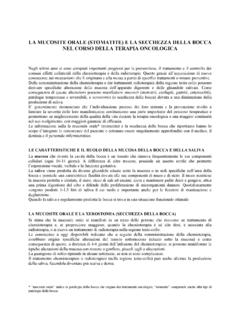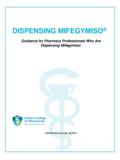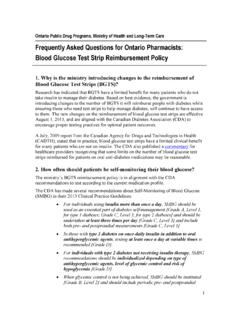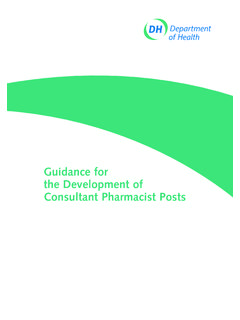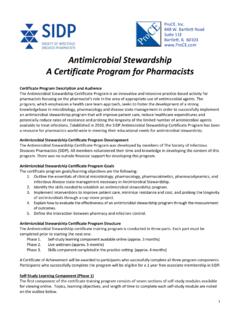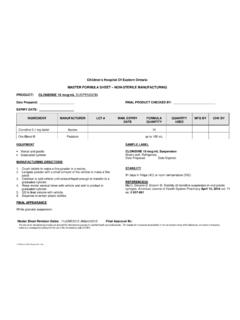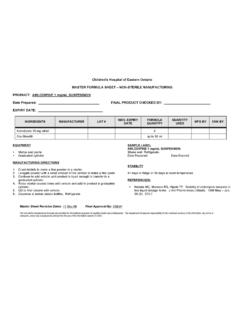Transcription of Drug interactions involving warfarin: Practice tool and ...
1 CPJ/RPC JANUARY/FEBRUARY 2011 VOL 144, NO 1 21 IntroductionWarfarin has been the mainstay of oral anticoagu-lant therapy for the past 60 years and it is most commonly used to treat or prevent thrombosis or thromboembolism in patients with venous throm-boembolism, atrial fibrillation and prosthetic heart However, this drug is efficacious only when the dosage is maintained within a narrow thera-peutic index, measured by the international nor-malized ratio (INR). Multiple challenges exist in appropriately achieving and maintaining therapy within this narrow index. Recent data have iden-tified genetic variants that may reduce a person s requirement for ,3 Furthermore, once a suitable dosage of warfarin has been established, control of therapy can be affected by changes in intake of vitamin K, development of acute medical conditions ( , fever, diarrhea), changes in certain chronic medical conditions ( , heart failure) and interactions with prescription, nonprescription and herbal numerous drug interactions involving war-farin are well known among health care providers.
2 Although community pharmacies have software systems that will alert users to a potential inter-action, these systems are limited in their capacity to assist the clinician in managing the interaction. Similarly, many published reports provide lists of drugs that are likely to interact with warfarin , along with their directional impact on the INR, but only rarely do they offer suggestions for managing the ,4 Data on the timing of the onset (and offset, namely the removal of the interacting drug with washout phase) of an interaction with war-farin, in addition to the mechanism, are needed to assist the front-line clinician in effectively manag-ing common drug interactions .
3 As such, we sought to compile a practical, user-friendly Practice tool that clinicians could use to proactively manage the care of individual patients during concomi-tant therapy with warfarin and drugs known to interact with warfarin . Development of the Practice toolThe Practice tool for drug interactions involving warfarin presented here was originally developed by a single practitioner ( ) working in an anticoagulation management service, who began charting common interactions between warfarin and other prescription drugs and the manage-ment strategies used to address them. A pharmacy resident ( ) further developed this chart by con-ducting a formal search of the literature to compile a list of established interactions between warfarin and other drugs.
4 Despite this literature review, it must be emphasized that the information in the Practice tool reflects years of experience in the tracking and proactive day-to-day management of common interactions by the 2 largest anticoagula-tion clinics in Alberta, namely the Anticoagulation Management Service at the University of Alberta Hospital and the Calgary Zone Anticoagulation Management Service. interactions specific to HIV-related medications were reviewed and refined by a pharmacist practising within this area ( ). The Practice tool does not include all documented interactions with warfarin , but instead focuses on those for which clinical management strate-gies have been employed by the 2 anticoagulation management services.
5 For interactions that are not proactively managed within these services yet are likely to be observed, evidence-based (as opposed to experience-based) information is presented. To ensure practical applicability, the Practice Drug interactions involving warfarin : Practice tool and practical management tipsTammy J. Bungard, BSP, PharmD; Erin Yakiwchuk, BSP, ACPR; Michelle Foisy, BScPharm, PharmD, FCSHP; Cynthia Brocklebank, PharmD, ACPRPRACTICE TOOLPEER-REVIEWED22 CPJ/RPC JANUARY/FEBRUARY 2011 VOL 144, NO 1tool contains information on aspects deemed pertinent in assessing and managing interactions for individual patients, including the effect on INR (in terms of both directional trend and severity), mechanism of the interaction, time of onset, offset and suggested management strategies employed by the anticoagulation management services.
6 We included only drugs with established interactions , ( , we excluded theoretical interactions ) and we did not include interactions with chemothera-peutic agents. Furthermore, we excluded herbal preparations and supplements, because of their heterogeneous nature. It should be acknowledged that some disease states, such as those produc-ing alterations in thyroid function, will alter the metabolism of clotting factors, which can, in turn, affect warfarin requirements. A detailed review of these drug disease interactions is beyond the scope of this article. The Practice tool was reviewed by the clinical pharmacist leaders and interested staff of 2 antico-agulation management services in Alberta.
7 Because the 2 clinical pharmacist leaders spearheaded the development of intellectual content for provincial educational programs focusing on anticoagulation management, a portion of the tool was integrated into those programs. Specifically, a portion of an earlier version of the tool was included in a paper-based overview entitled Anticoagulation: On the Road to Practice Change and another version was included as a handout for individuals attending a 2-day workshop administered through the Office of Continuing Pharmacy Education, Faculty of Pharmacy and Pharmaceutical Sciences, Univer-sity of Alberta, in the fall of Since then, the Practice tool has been updated as described of drug interactionsWarfarin is well absorbed, is highly bound to the plasma proteins (99%) and is metabolized via the cytochrome P450 It is an indirect antico-agulant, exerting its effect by preventing the inter-nal recycling of oxidized vitamin K to reduced vitamin K.
8 Reduced vitamin K is necessary to enable carboxylation of the terminal g-glutamic acid residue of the vitamin K dependent clotting factors (factors II, VII, IX and X). The metabo-lism of warfarin allows for both pharmacokinetic and pharmacodynamic mechanisms for drug interactions . Induction or inhibition of cytochrome P450 isozymes warfarin has 2 active The S-isomer is approximately 2 to 4 times more potent than the R-isomer and is metabolized primarily by the cyto-chrome P450 2C9 isozyme (CYP2C9). The R-iso-mer is metabolized by cytochrome P450 1A2 and 3A4 isozymes. Drugs that induce or inhibit these enzyme systems have the ability to alter warfarin metabolism and to decrease or increase the INR, respectively.
9 Most notable are interacting sub-stances that affect CYP2C9, given the increased potency of the S-isomer. interactions involving these isoenzymes tend to be delayed, for a variety of reasons. First, the complete effect of the inter-action will not be observed until the interacting agent has reached a steady state (about 5 half-lives).6 Second, given the indirect effect of warfa-rin, time must be allowed for the newly established warfarin concentration to affect the vitamin K dependent clotting factors being newly synthesized by the liver. Concomitantly, clotting factors present in the circulation before initiation of the interact-ing agent must be depleted.
10 An effect on the INR is typically observed within 3 to 5 days for interacting substances with short half-lives. The effect on the INR of drugs with longer half-lives will be even further delayed. Generally, onset and offset occur over similar intervals. Relative to inhibitory inter-actions, the onset of induction interactions takes longer because of the time required for up-regu-lation ( , the process of induction) and synthesis of new proteins and enzymes. The full impact of steady-state interactions may not be apparent for 2 to 3 weeks, depending on the inducer involved. Likewise, when the inducer is discontinued, a wash-out period of several weeks may be required before normalization of the hepatic enzymes.

